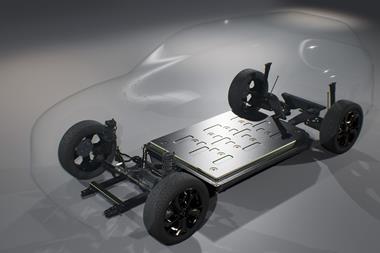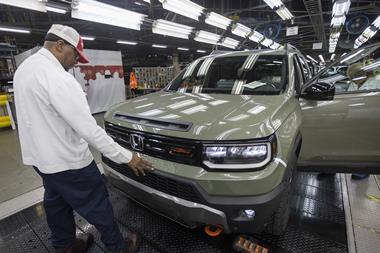Phil Kienle, vice-president of Manufacturing for GM International Operations (GMIO and GM China) discusses the production challenges of meeting rising demand in China
AMS: How has GM standardised its manufacturing operations globally and is China now operating at a level comparable with GM’s other high-volume production regions?
Phil Kienle (PK): When you talk about this from an equipment standpoint, within SGM we pretty much follow GM’s build process across body, paint, general assembly, powertrain, etc. So there’s a great alignment there. SGMW is a little different as they are more of a value proposition and so follow some of our bill of process, but they have a unique process based on their equipment for [building] mini commercials. However, they are now moving into passenger car production and as this increases they will adopt more of our processes.
From an operational standpoint, all the plants are essentially identical. All the plants have adopted our global manufacturing system (GMS) in terms of the five pillars [principles] and you won’t notice any difference globally between plants in terms of that operating system.
The expectation is to be common across the global network and here we are continually benchmarking both internally and externally. Our China locations are as good, if not better in certain areas, than our plants in the US and Europe. When you look at our strokes per hour, hours per vehicle, costs per unit, our China plants are amongst the best globally.

PK: We’ve been operating in China for about 20 years but the plants in the US and Europe have been producing vehicles for far longer. So from that standpoint, we’ve been building cars here for a relatively short time – but our cycles of learning have been incredible.
When you look at the number of new plants we have built in China, it has afforded us the opportunity to try out new technologies and processes. A greenfield site offers the perfect clean slate to try something new. This differs from the US and Europe, where the focus has been on right-sizing volumes.
We have trialled and developed a lot of new paintshop technologies here, such as three-wet technology, dry scrubbers, etc, and these have now been adopted in the plants in the US and Europe. So I would say many of the new processes in terms of manufacturing engineering have been initiated here and then transferred across the rest of the network.
AMS: How have you prepared manufacturing operations for fluctuations in demand?
PK: To give you some sense of scale, the China market [vehicle production] last year was around 24m units and this year we [GM China] are going to produce 4m vehicles. If you take a conservative estimate of market growth in the next year of around 7%, that amounts to an additional 300,000 vehicles for us to produce; that’s the equivalent of another production plant. So that means we potentially need to build a new plant each year just to keep up with market demand.
Right now, we are in an enviable position in that we have to work out how we can grow but avoid overproduction. The market is becoming increasingly segmented and we’re seeing a lot of variants in the models produced, so when we look at our plants the three things we try to moderate are, first, tool flexibility. The tooling should be able to produce multiple models and avoid having dedicated tool sets. Second, flexible facilities. We build in a lot of capability to produce the same model at multiple locations so that if demand increases rapidly we have a ‘flex-valve’ – the capability to add production when needed.
The third element is people. We spend a great deal of time and effort training our workforce but we also maintain a certain level of contract employees so in the event of unforeseen circumstances we can shed some of the contract resources but maintain our core skilled workforce.
"Our China locations are as good, if not better in certain areas, than our plants in the US and Europe” – Phil Kienle, GM China

PK: In some areas, such as the paintshop we will protect floorspace for additional capacity or upgrades to the process, but in areas like the bodyshop there is very little spare space as we design the lines to be as flexible as possible to minimise the need to add additional lines.
AMS: What production challenges does China present?
PK: Referring back to rate and speed of growth here in China, developing and maintaining a skilled workforce is a challenge. The joint ventures have been able to develop skilled workers very quickly. If you look at the people running our plants here, they are around 30 years old. They are given numerous cross-functional assignments and are uniquely qualified to take on leadership roles. Whereas in the US or Europe, a person of the same age might be a shop leader rather than plant manager; but out of necessity the talent here is pushed, and to date they have excelled. It’s certainly not easy but we need the local talent to lead the plants.
The other big challenge is the increasing fragmentation of the vehicle segments. So there are now sub-segments developing, which adds complexity to the manufacturing operation as we try to be responsive to the market.
AMS: The new plant at Wuhan is reported to be highly automated. How does this level of automation compare with the other GM manufacturing sites in China and globally?
PK: Wuhan will be one of our most automated plants globally, with around 95% automation levels and it’s also our newest plant. SGM is continuing to add automation to its plants, primarily in the bodyshop area. Given the rising costs of building cars in China and the increasing volumes, there is a very good business case for automating here.
AMS: For powertrain production at Wuhan, what production operations (casting, forging, machining, etc) are planned for the plant, or will it be assembly only?
PK: At Wuhan we do the machining of the head, block and crank, and assembly, but we don’t have any onsite casting facilities. We don’t have any plans to add this operation as we have a great partner in SAIC that provides access to good suppliers.
AMS: What is the current level of local content (components) in the vehicles produced in China and does this vary model to model?
PK: If you look at our SGMW product, it’s 100% localised content. Overall in SGM we are probably at about 85% localisation, but products such as Cadillac have less local componentry and that’s mainly due to current volumes. We are looking to increase the levels of localised content across the product range, developing stronger relationships with tier-two suppliers.
AMS: Have you established a supplier network for production equipment in China?
PK: There are a lot of global equipment suppliers that have established locations in China, for example for paintshops Dürr is present here in China. However, we now use all Chinese press lines, as working with the supplier we have seen incredible progress in developing the equipment. These presses have high levels of uptime, throughput and produce world-class quality parts at a cost that is significantly less than imported equipment. So, our focus has been on developing the local suppliers' capability and now the vast majority of our equipment is purchased in China.
 The paintshop has been upgraded at Jinqiao North plant
The paintshop has been upgraded at Jinqiao North plantMeanwhile, a new plant adjacent to the existing North and South plants is in the final stages of construction and will be dedicated to building Cadillacs. The models have yet to be confirmed, but the OEM currently builds XTS and ATS-L models in China. According to David Gibbons, deputy executive director for Manufacturing, the new plant will be equipped to produce multi-platform architectures and will feature a state-of-the-art bodyshop able to handle multi-material joining processes, plus a paintshop that will apply the latest coatings available at GM. Gibbons also noted that the general assembly shop would be adaptable for all possible platform variants, including electric or hybrid vehicles.
With so much development of the site ongoing at the time of our visit, we were limited to viewing the assembly shop in the newer South plant. The facility started production in 2005 and produces the Excelle, Regal, LaCrosse and ATS-L models. It shares the high-volume production of the Excelle with the North plant (which also produces the Malibu and XTS models), depending on demand. Gibbons explained that both plants have the flexibility to meet changing levels of demand, particularly on the Excelle. He described the shift in production between the two plants as a ‘spring’, expanding and contracting as needed.
General assembly is laid out in a ‘T’ configuration with the mixed line handling four models built across three different platforms. At the time of our visit, the plant was operating at maximum utilisation at 42 jobs per hour using three crew/two shifts. Points of interest included the extensive use of kitting illustrated by each of the vehicle doors and the matching kit of parts, travelling together along the assembly line. The seats and dashboard exemplified just-in-time philosophy, being delivered ready assembled to the line on demand by the supplier, with no stored inventory at the plant.
• Shanghai General Motors (SGM) – This joint venture between SAICMOTOR and General Motors was established in 1997. SGM has four major manufacturing bases: Jinqiao in Pudong, Dongyue in Yantai, Norsom in Shenyang and Wuhan in Hubei, as well as nine vehicle plants and four powertrain plants.
• SAIC-GM-Wuling (SGMW) – This joint venture is between GM China, SAIC and Wuling Motors and is based in Liuzhou, Guangxi Zhuang Autonomous Region, in south-western China. It has a second manufacturing base in Qingdao, Shandong, and a third base in Chongqing Municipality. SAIC-GM-Wuling manufactures a range of Wuling brand mini-trucks and minivans as well as a growing family of Baojun brand passenger cars.





































